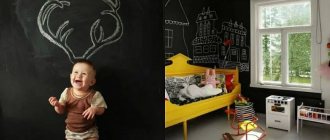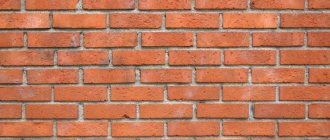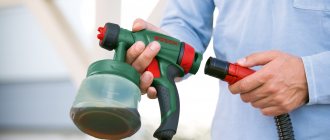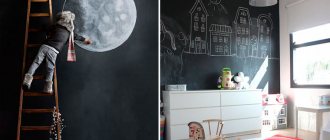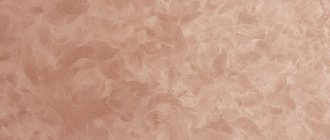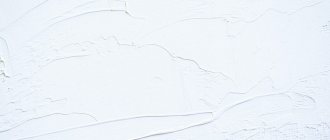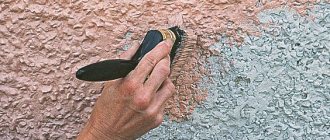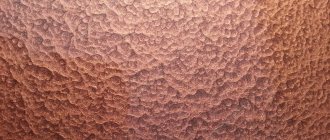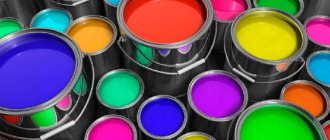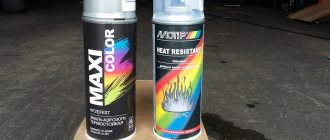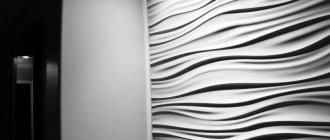Paint Features
An ordinary slate board in brown, black, or less often dark green (the color of the “forest thicket”) is familiar to everyone who once attended school. The chalk surface allows you to draw on it with multi-colored crayons, the magnetic surface allows you to attach magnets, there is also a magnetic chalk version that combines the properties of the previous two.
The paint consists of a pigment, a water-based latex base, with the addition of gypsum, acrylic resin, marble chips, and metal dust is introduced into it to create a magnetic surface. If desired, you can make the graphite composition yourself by mixing acrylic pigment, gypsum, and water in a ratio of three to two to one. You can choose any dye, the ready-made composition is several times cheaper than the purchased one, but it holds up worse and is less durable. Marker and magnetic marker compositions also fall into this category - they are made from synthetic polymers with additives and have a texture similar to the graphite version. They do not draw on this coating with chalk - only with a special, easily erasable marker.
The materials described are unique in that they can be used to decorate not only the wall, the floor, but also the entire area of the kitchen apron, cabinet door, refrigerator, headboard or foot of the bed, or to create a work, study, or dining area. The coating comes out matte, resistant to mechanical damage, and slightly rough. The graphite wall will perfectly decorate such interiors as:
- loft;
- industrial;
- techno;
- African;
- brutalism;
- Scandinavian;
- minimalism;
- avant-garde;
- manga;
- grunge;
- eclecticism. This material is practically unacceptable in the classical style, baroque, gothic, empire, art nouveau, ecological, ethnic, Victorian, Indian, country, Provence, Arabic, conservatism and some others.
The coating is difficult to wash off after drying, so floors, window sills, and other places where the dye should not get in are covered with film.
What is chalk (slate) paint
Chalk paint belongs to the category of water-dispersible paint. It consists of a latex base, acrylic resins, modifying additives and filler (gypsum, marble chips, etc.). Due to the multiphase structure, the finished layer is matte and slightly rough. You can draw, write and take notes on it, and then wash off the chalk with a damp sponge without the risk of damaging the coating.
Chalk paint is a solution consisting of chalk and water, to which a certain amount of mineral additives has been added.
The latex base ensures water resistance and long life of the paint. Since solvents and toxic additives are not used during the work, the pigment does not irritate the eyes and respiratory tract during the drying process.
Chalkboard dye is used for finishing walls and furniture, restoring chalkboards, decorating souvenirs, etc.
The paint has good adhesion to plaster, wood, wallpaper, drywall, metal, plastic, ceramics and glass. When finishing objects upholstered with fabric, you can apply the dye to the entire surface at once, without resorting to special preparation methods.
In some sources you can find another name for this finishing material: graphite paint. It is not due to the composition of the product, but to the similarity of the coating to a slate board.
Advantages and disadvantages
Slate paint and varnish material, which is often called graphite, has a number of significant advantages and disadvantages.
Positive properties:
- the coating is not afraid of fire, resistant to scratches and chips;
- can be used to restore various household items - from cabinets, refrigerators to flower pots, glassware;
- does not contain harmful, toxic substances;
- practically odorless, which is very convenient when decorating a nursery, kitchen, cafeteria, restaurant;
- on a surface treated with this material you can draw with colored chalk;
- everything that is written and drawn on the graphite wall can be easily erased with a regular damp cloth;
- Great for rooms frequented by children who have a habit of drawing on the walls;
- can be applied without problems to most known materials, can be easily updated if necessary, and adjusted using sprays matched to the tone;
- if the material is planned to be used in a children's bedroom, this will help free up a significant part of the space in which a huge board on an iron stand could stand.
The negative sides are:
- the paint, with the exception of some varieties, is not suitable for outdoor use in cold regions - the coating quickly loses its appearance due to temperature changes;
- unheated summer cottages, bathhouses, and open verandas are also rarely painted with slate compounds;
- if the wall is not periodically cleaned of chalk, it looks sloppy;
- the functional coating has no decorative value;
- the material is produced mainly in dark colors, which is not suitable for every interior, making the room gloomy if used excessively;
- a monochromatic coating can quickly get boring;
- regular chalk crumbles a lot, so it is recommended to use special dust-free pastel crayons;
- if the plane is overly textured, the “blackboard effect” will not work on it - careful leveling followed by sanding is required;
- chalk dust is harmful to people prone to allergies.
The combination of several colors in one room looks the most beautiful.
Types, release form
Graphite dyes are produced in liquid form, packaged in metal cans and spray cans. Some manufacturers offer entire sets designed for various purposes. This can be paint plus a spray, a liquid transparent material plus several tinting agents, a slate composition plus a primer containing iron particles, with the help of which a magnetic layer is created, etc. The shelf life of paints is about two years.
Marker paint can be matte, glossy, or semi-matte. They draw on it with a special marker and erase the marks with a microfiber cloth. The cost of the material is 70-200 rubles, it is produced in containers of 500-1000 ml, the packaging is enough for 3 or more square meters. When sold as a set, it includes a clear varnish with a hardener, a cup, a stirring stick, an application roller, rubber gloves, and a tray.
Color variety
Chalkboard paints are available in various colors:
- black;
- white;
- gray;
- green;
- brown;
- lilac.
The most common are matte black options - it is easy to draw on such a surface with any crayons, creating an image of the highest possible clarity. Transparent compositions are widely used - pigment is added to them independently, creating mixtures of varying degrees of saturation.
Magnetic paint – universal holder
Unlike graphite and marker paint, magnetic paint is not so much a topcoat as a base coat - it is only available in rich gray color and is usually used in conjunction with color compositions. The best option is a combined coating of a magnetic base and a tinted or transparent slate or marker layer; on the surface you can write/draw and attach notes, drawings, recipes, stickers and similar information carriers or souvenirs. If you don’t plan to paint on the walls, then use magnetic paint with any decorative paint, only as a holder.
Magnetic paint can also be applied to different substrates. When the walls are covered with it, they are first leveled and degreased. If the previous compositions were used in one thin layer, then the magnetic one, on the contrary, is applied in several (up to 4) layers. Since the composition contains metal particles that attract a magnet, their quantity must be sufficient to hold the carrier. One layer dries for about 5 hours; after applying the final layer, the wall is left for a day, and after that, it is decorated with a topcoat or used in its original form.
When a magnetic surface is combined with a marker surface, before applying marker paint, the base must be thoroughly sanded, since the magnetic textured coating is rough, and then the surface must be primed. A liter jar of magnetic paint costs from 2.5 thousand rubles, but due to layer-by-layer application, it is only enough for a couple of m². Some manufacturers produce sets of magnetic and slate paints at once.
Advice from designers and a selection of the most popular categories can be found in our article on modern interior materials. Warm plaster can be one of the bases for slate and other paints. The video about tinting paints reveals the process of obtaining the desired shade.
Application area
The surface, painted with graphite paint, will diversify the familiar interior in an original way. The material is easily applied by hand to:
- plastered walls;
- tree;
- chipboard;
- MDF;
- OSB;
- Fiberboard;
- wallpaper for painting;
- glass wallpaper;
- metal;
- glass;
- ceramics;
- drywall;
- PVC.
In this way, you can paint the entire apartment, as well as individual elements of the furnishings - furniture facades, columns, ventilation ducts, kitchen aprons, bathroom walls, flowerpots, kitchen trays, boxes, storage boxes. The slanted walls of the attic, painted with slate paint, and the side parts of the staircase leading to the second floor of a private mansion look interesting. School classrooms, rooms for teaching classes in kindergarten, cafes, offices, interest clubs.
In the kitchen
The kitchen space is usually decorated with warm, rich colors, less often - dark, monochrome. Often, a kitchen apron is painted with graphite paint - during cooking, the recipe is copied onto it, which allows you not to refer to a book, magazine, notebook every time, a table of measures and weights of various products will also come in very handy. If the ventilation duct is highlighted in color, then this inconvenient element becomes accentuated. Magnetic graphite dye is used to decorate the refrigerator, paint jars for bulk products, and then use chalk to indicate what’s inside.
If the kitchen room is combined with a reception area, on one of the walls they draw something like a chessboard with two contrasting compositions with a magnetic filler - chess and magnetic checkers are made with your own hands from polymer clay and other materials.
In the nursery
In children's walls, furniture pieces painted with a graphite mixture play an educational role - the child is allowed to draw on them, wash them, and immediately create another drawing in place of the previous one. For parents, this is much more convenient than re-pasting the wallpaper in the room three times a year or constantly washing and tinting walls covered with other materials. The children's table is also painted: the children themselves will draw on it whatever they want with crayons - a “chain” with numbers for playing with cubes, a chessboard, a labyrinth for cars, “tic-tac-toe”, etc. You can entertain the baby by tracing his shadow on the wall, palms or feet of all family members. The learning area is painted black or dark green - here the youngest student will master mathematical operations, learn to write letters, etc.
Here, each wall is painted in its own color – this makes the space look more cheerful.
In the living room
In the hall, one large wall is usually decorated with graphite composition - the “motto of the day” is written on it, which is changed periodically. If you have a home office, important notes are placed on its wall; the slate surface will also help people who are studying a foreign language - complex words will always be visible and easy to remember. You can even paint zoning partitions in combined kitchens-living rooms, bedrooms-living rooms, and studios. Decorative items such as flower pots and bottles are also sometimes painted.
In the bedroom
The bedroom is a place for relaxation, so bright, flashy colors are undesirable here. The exception is the newlyweds' room, painted scarlet, red-orange, symbolizing passion. A chest of drawers, a wardrobe, drawers in a dressing room can also be painted, and then labeled with chalk what is where. The sleeping area is sometimes highlighted in black, creating some privacy; a mini-office space, a place for reading or handicrafts - in a lighter color.
Hallway
The space for drawing does not have to be made in the children's bedroom - the corridor is no less suitable. For forgetful family members, “reminders” are written here - take the keys, take out the trash, turn off the lights, walk the dog, etc. You can paint the front door with matte slate paint - the hallway will become completely unique. When there is a landline “home” telephone in the hallway, which is still occasionally used, the wall serves as a surface for recording numbers and other important information that needs to be saved immediately.
In catering establishments
In small eateries, cafes, bars, the current menu or even the Wi-Fi password is written on slate surfaces. In larger catering premises, children's corners are decorated with small boards, where people leave their children so that they do not interfere with adults communicating with each other.
Visitors write wishes and reviews on the walls, the staff leaves messages about ongoing tastings, promotions, discounts, decorates the establishment in a new way for each holiday, drawing snowflakes for the New Year, angels for Christmas, hearts for Valentine’s Day, depicting dates, congratulations for anniversaries, corporate parties, wedding events.
Application of slate coating in the interior
Chalk paint is widely used in all interior styles. It is indispensable when decorating schools and preschool institutions. In the classroom, you can paint a small section of the wall with it and use it as an addition to the existing board. In everyday life, such walls are optimal in children's rooms, in the kitchen and even in the hallway. For young children, this is the best option for developing creativity. It is convenient for schoolchildren to perform calculations on such a wall, especially in geometry, draw diagrams, and so on.
For young children, this is the best option for developing creativity.
In the kitchen and hallway, slightly smaller areas need to be painted. You can quickly write down a recipe on them, make a note, attach a shopping or to-do list, or leave a message for your household.
In the kitchen and hallway, slightly smaller areas should be painted.
Interior items painted with chalkboard paint look original. These could be cabinet doors, small vases, a kitchen apron, a countertop, individual elements of dishes and much more. On an industrial scale, such objects can be found in bars, cafes and some restaurants. They usually contain the menu of the day, various promotions or reviews from visitors.
Interior items painted with chalkboard paint look original.
How to prepare a wall for painting
Preparing the wall for painting with a graphite composition is the same as for other similar types of finishing. First you need to completely remove the remnants of old coatings - wallpaper, paints, films, plasters. Afterwards, the surface is carefully leveled, a primer is applied, and the layer is carefully sanded. When applied to metal, wooden surfaces, products, they also need to be pre-primed.
If the old paintwork still holds up well, it is cleaned, degreased using household detergents, sanded until matte, and dust is removed. When you plan to paint not the entire wall, cabinet, table, but only a small part, the boundaries are created using masking tape.
Rules for using graphite paint: preparation and painting
The main feature of working with graphite paint is its ease and ease of application. There is no need for special knowledge, experience or special professional tools. It is enough to purchase a regular painter’s kit, which includes:
- paint tray;
- brushes of different types;
- construction roller.
Before starting work, surfaces that are not to be painted should be thoroughly covered with cellophane film, since even with all the care of application, drops may get on the floor, which are very difficult to remove. To protect against paint, cover window sills, window frames and doors with paper tape.
Graphite paint hardens very quickly, so it must be applied very carefully.
The wall to be painted must be carefully leveled:
- remove old paint and wallpaper;
- remove old peeling putty material and apply a new layer;
- coat the surface with primer.
If the wall is old, then it is best to completely remove the worn putty and re-putty the surface, and then apply a primer that is suitable for this type of paint. Only after this procedure can you start painting.
The surface painting itself is very simple. The main thing is that the base for application is clean, free of dust and dirt. The paint must first be thoroughly mixed and then poured a little into a special tray or other container, as it hardens quickly. Next, taking a small amount of product with a roller or brush, distribute it on the surface. After two hours, the second layer is applied. You can draw and write on a slate board after three days.
The magnetic coating after slate paint is applied a day later, if the iron-magnetic powder has not yet been added to the composition of the paint and varnish.
Three days after application, you can draw and take notes on the slate coating
Application technology
The paint is applied with a short-pile roller (it is made of microfiber or velor), with a soft brush; small curved parts can be painted with a foam swab, a spray can, or a special spray device. It is important to take into account that the composition hardens very quickly; it is recommended to apply it in several layers so that the painting is uniform. The dye is applied from a can from a distance of 20-30 cm from the wall being treated.
If the paint has thickened, it is diluted with clean water, adding up to 7-10% to the existing volume. Application is carried out at a temperature of +9C - +29C - in extremely cold rooms, as well as outdoors in winter, the composition will not stick. Paint consumption for single-layer application is 120-130 ml per square meter. m.
When the mixture is made from “survival materials” with your own hands, it must be thoroughly mixed until a homogeneous consistency is obtained.
What to paint under the slate
Chalkboard paints can be used throughout the home:
- In the nursery. If you install a large board here or paint over an entire wall with chalkboard, children will have a place to create and learn. And the rest of the walls in the house will be completely safe.
- In the kitchen. Individual slate boards, kitchen aprons, and painted kitchen cabinet doors look very nice here. You can write down recipes, menus, reminders, shopping lists, and just declarations of love for each other on them.
Important! Some paints become discolored by hot grease, so they should not be applied near a stove.
A variety of materials can be painted to look like lead:
- wood, chipboard, MDF, fiberboard;
- metal;
- plaster;
- drywall;
- brick;
- glass;
- ceramics.
Dyeing technology
Chalkboard paint is very easy to use. Anyone can paint a wall or make a cute note board with their own hands.
The painting procedure is as follows:
- The surface to be painted should be cleaned of old coatings. If necessary, it is leveled with putty or sanded, and then washed to remove dust and dried.
- To ensure that the paint lies evenly, the surface underneath is primed and dried. Ideally, you should use a special primer for slate paints.
- To create a neat slate rectangle on the wall or refrigerator door, cover the surface around the perimeter with masking tape.
- The emulsion is mixed well and applied in several layers. Each layer must be completely dry before the next one is applied. Painting should be done in a ventilated area with an air temperature of +10°C and humidity up to 85%.
Advice! Slate paints harden quickly, so you need to work with them quickly.
You can wash the slate surface with soap or other household chemicals only a month after painting.
Manufacturers rating
The modern market offers a wide range of coloring compositions from domestic and foreign manufacturers. They differ in: color, degree of matte, consumption per square meter, packaging volume, country of origin. Prices vary greatly, but on average, a 0.75 liter can of slate paint costs about 1,000 Russian rubles, and a liter of marker composition costs up to 8,000 rubles. The cost of application work ranges from 220-600 rubles per sq. m., depending on the type of surface and the number of layers. Alignment, priming of the wall, coating with a magnetic layer, original surface painting are paid separately.
1st place: Blackboardpaint
The Magpaint brand from the Netherlands is one of the well-known companies that produces slate paints: black and transparent Blackboardpaint. Transparent options, if you add a tinting compound to them, will take on almost any color. Black paint is available in jars of 500 ml, 1.0, 5.0 liters, transparent - 0.5 and 1.0 liters. The compositions can be applied with a roller, brush, or spray gun; drying time is six hours, complete drying is three days. The cost of one liter is 1600 rubles, this amount is enough to cover 7-10 square meters. Work of an application specialist – 267 rubles. per sq. m.
2nd place: Siberia slates
Slate coloring agents are produced in Russia - these are tintable paint “Siberia”, “Siberia PRO”. The material is highly wear-resistant; antifungal components are added to it; it is advisable to apply it in two layers, if necessary in three. Water resistance is also “high”, which allows the composition to be used in the kitchen or outdoors.
One liter is enough to paint 4.8-9.5 square meters. m. when applied in one layer. The average price for a liter jar of “Siberia PRO” is 1090 rubles, “Siberia” tinted is 990 rubles. The usual Siberia packaging is available in stores in 0.2, 0.5, 0.9, 1.0 liters. Colors – black, blue, green, brown, gray, blue. Other shades are created using a special slate base. "Siberia PRO" is applied by spraying and is available in packages from one to five liters. Paint application costs 220-247 rubles. per square meter.
3rd place: Krylon Chalkboard Paint
The chalkboard composition “Krylon Chalkboard Paint”, produced in the form of a spray of black, less often - green, paint with the effect of a school board “Krylon Chalkboard Paint” quart is produced by the brand “Krylon”, located in the USA. Krylon Chalkboard Paint spray is sold in 350 ml cans, Krylon Chalkboard Paint quart - in 950 ml cans.
The price of one liter of spray “Krylon Chalkboard Paint” is 2700 Russian rubles, “Krylon Chalkboard Paint quart” is 1500 rubles. When painting walls, furniture, or decor by spraying, it is recommended to protect the respiratory tract with a respirator, gauze bandage, and eyes with special glasses. Drying time for a single layer is 1-4 hours, complete drying is 24 hours. A liter package is enough to paint 4.2-5 square meters. The work of painting surfaces with such compositions costs 272-600 rubles. per square meter
4th place: Tikkurila Liitu
Slate paint "Tikkurila Liitu" is available in black and also tinted. They are produced in Finland, by the Tikkurila brand. The surface comes out matte, can withstand up to 5000 erasing and drawing cycles, chalk is easily washed off with a damp cloth. The cover is environmentally friendly, has a rich color, and is suitable for high-quality restoration of school boards, decoration of walls, and furniture surfaces. The only drawback is the relative difficulty of application.
The cost of a one-liter metal can with black composition is 1100 rubles, tinted can is 1340 rubles. The drying time of a single layer is about six hours, the final drying of the surface occurs in 6-7 days, depending on the temperature and humidity of the surrounding air. A liter jar is enough to paint 4.5-4.8 square meters. walls, other surface. The price of painting is 244-297 per “square”.
5th place: Le Vanille
produces a slate composition called “Le Vanille”, the company itself is located in the Netherlands. The paint is produced in liter cans, the cost of a liter of this paint and varnish product is 1,550 rubles. One layer of material dries in two hours, and is dried until completely ready for use in five days. The approximate consumption of the coloring agent is liter per 5-5.5 square meters. When carefully applied to the surface to be treated, a uniform matte finish is obtained, reminiscent of a blackboard. The cost of working with paint is from 387 rubles per square meter.
6th place: Rainbow VD-AK 1170
The slate product “Rainbow VD-AK 1170” from the domestic manufacturer of paint and varnish compositions “Rainbow” is produced in metal cans with a volume of 0.9 liters. It is applied with rollers, a soft wide brush, or a spray gun; drying time for each layer is one hour, complete drying time is up to seven days. A liter jar is enough to paint 4.7-9 “squares”, its cost is 1200 rubles, the cost of application work is 266 rubles. per sq. m.
The coating is intended for repair work on damaged school boards of various colors, painting furniture, walls, on which it is subsequently planned to draw with chalk. It is used for interior and exterior work and has high abrasion resistance – up to 10,000 cycles. To ensure that painted items last a long time, they should be protected from direct sunlight. When it is necessary to make the surface magnetic, it is pre-treated with a special iron-containing primer from the same company.
7th place: Rust-Oleum
Good slate options are produced in the USA - black “Rust-Oleum”, volume 946 ml, “Rust-Oleum spray”, packaged in 312 ml. When using the latter, it is necessary to use personal protective equipment for the respiratory system, eyes, and skin from the dye, particles of which enter the air. The composition is used exclusively for interior spaces; it is applied in two or three layers. You can only draw on the coating with carbonate crayons, since other options severely scratch the surface.
Black “Rust-Oleum” should not be diluted with water; it dries in two hours, and is completely dry in three days. The spray will take one hour plus three days to dry. The approximate consumption of liquid dye is one liter per 3.7-3.9 square meters. m., spray - 2.6-4 sq. m. The cost of a liter of black paint is 1690 rubles, spray in cans is 2080 rubles, application by a master is 450-650 rubles per sq. m. meter.
Types of chalk dyes
To choose the right finishing material, you need to know what chalk paint is and what types of it exist on the market. Depending on the composition it can be:
- Chalk (slate). Suitable for drawing with crayons, resistant to abrasion and moisture. This paint is also used for furniture restoration.
- Magnetic slate. This coating allows you to attach small magnetic figures, photographs, notes and other lightweight objects to the surface of a board or wall. The dye contains small iron particles that close the field lines. Magnetic effect paint has a small palette: most manufacturers produce it in 3-5 shades. It can be black, green, blue, gray or brown. To change the color of the wall, cover it with 1 layer of chalk composition. Multi-layer finishing weakens the magnetic properties.
- Marker. Designed for drawing with water-based markers. Suitable for people with allergies to chalk dust and those who do not want to regularly remove traces of chalk from the floor. The coating is smoother and more durable, but takes longer to dry. In addition, the price of such a dye is higher than that of a classic slate dye.
Magnetic chalk paint has appeared on the market relatively recently.
